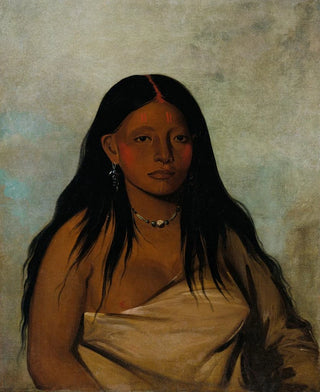Art print | Sh-De-Ah Wild Sage, a woman from Wichita - George Catlin


View from behind

Frame (optional)
George Catlin's captivating introduction
In the vast panorama of American art, the work "Sh-De-Ah Wild Sage, a woman of Wichita" by George Catlin stands out for its narrative depth and visual authenticity. This painting, created in the 19th century, transports us to a world where the cultural identity and traditions of indigenous peoples are celebrated with rare sensitivity. Through Catlin's gaze, we discover not only a woman but also the story of a people, a living testament to the cultural richness of the Wichita. The art print of this work allows us to appreciate a snapshot of history while offering a reflection on the artistic and cultural heritage that endures.
Style and uniqueness of the work
George Catlin's style is characterized by a realistic approach and attention to detail that go beyond a simple portrait. In "Sh-De-Ah Wild Sage, a woman of Wichita," vibrant colors and delicate textures pay homage to the natural beauty of the protagonist. Catlin does not merely depict a figure; he captures the very essence of her identity, incorporating elements of Wichita culture into his composition. Every brushstroke seems to tell a story, every color evokes an emotion. The posture and expression of the woman reveal a quiet strength, a dignity that engages the viewer. The work thus becomes a bridge between the past and the present, an invitation to explore the roots of Native American culture through the lens of art.
The artist and his influence
George Catlin, often considered one of the first artists to document indigenous peoples of America, dedicated his life to capturing the soul of Native nations. His work is not limited to painting; he also engages in a reflection on the preservation of cultures threatened by colonial expansion. Catlin traveled across the United States, meeting and living with different tribes, which allowed him to develop a deep understanding of their traditions. His influence extends well beyond his time, inspiring many artists and historians to explore and valorize indigenous cultures. Thanks to his commitment, works like "Sh-De-Ah Wild Sage" remain valuable testimonies, reminding us of the

Matte finish

View from behind

Frame (optional)
George Catlin's captivating introduction
In the vast panorama of American art, the work "Sh-De-Ah Wild Sage, a woman of Wichita" by George Catlin stands out for its narrative depth and visual authenticity. This painting, created in the 19th century, transports us to a world where the cultural identity and traditions of indigenous peoples are celebrated with rare sensitivity. Through Catlin's gaze, we discover not only a woman but also the story of a people, a living testament to the cultural richness of the Wichita. The art print of this work allows us to appreciate a snapshot of history while offering a reflection on the artistic and cultural heritage that endures.
Style and uniqueness of the work
George Catlin's style is characterized by a realistic approach and attention to detail that go beyond a simple portrait. In "Sh-De-Ah Wild Sage, a woman of Wichita," vibrant colors and delicate textures pay homage to the natural beauty of the protagonist. Catlin does not merely depict a figure; he captures the very essence of her identity, incorporating elements of Wichita culture into his composition. Every brushstroke seems to tell a story, every color evokes an emotion. The posture and expression of the woman reveal a quiet strength, a dignity that engages the viewer. The work thus becomes a bridge between the past and the present, an invitation to explore the roots of Native American culture through the lens of art.
The artist and his influence
George Catlin, often considered one of the first artists to document indigenous peoples of America, dedicated his life to capturing the soul of Native nations. His work is not limited to painting; he also engages in a reflection on the preservation of cultures threatened by colonial expansion. Catlin traveled across the United States, meeting and living with different tribes, which allowed him to develop a deep understanding of their traditions. His influence extends well beyond his time, inspiring many artists and historians to explore and valorize indigenous cultures. Thanks to his commitment, works like "Sh-De-Ah Wild Sage" remain valuable testimonies, reminding us of the






